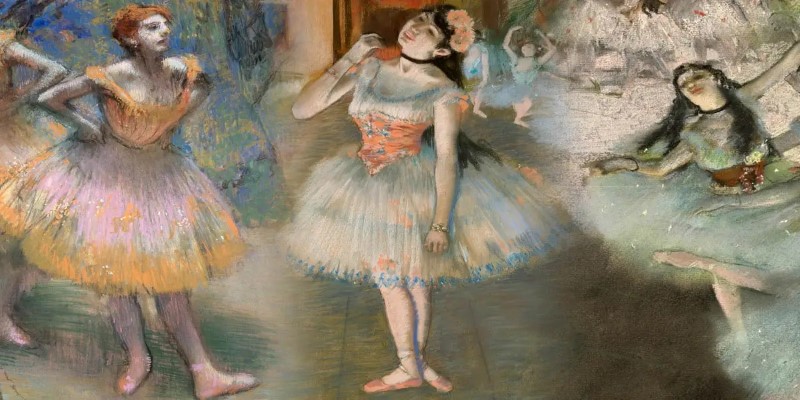
Mastering the Art: Recreating Degas' Harmonious Colour Symphony
Jan 30, 2024 By Eleanor
Edgar Degas, a maestro of the art world, left an indelible mark with his distinctive approach to colors. In this exploration, we embark on a journey to understand and recreate the mesmerizing color palette that defined Degas' artworks.
The Artistic Influence
Renowned for his distinctive impressionist style, Edgar Degas found inspiration in the tapestry of everyday life, with a keen focus on ballet dancers, horse racing, and the vivacity of Parisian scenes. His color selections served as a mirror to the lively energy and dynamic essence woven into these subjects.
Degas, a master of capturing the nuances of movement and atmosphere, skillfully translated the vitality of his chosen themes onto canvas through a vibrant palette. This deliberate choice of colors not only defined his artistic signature but also elevated the emotive resonance of his paintings, making them timeless reflections of life's pulsating rhythms.
Decoding Degas' Colour Palette
Let's delve deeper into each aspect of decoding Degas' color palette:
Soft Pastels
Edgar Degas, known for his distinct style, often used soft pastel shades like gentle pinks, blues, and greens. Picture a ballet dancer's costume bathed in a soft pink glow or the serene sky in his outdoor scenes with calming blues and greens. These hues created a harmonious and ethereal ambiance, evoking grace and tranquility in his paintings.
Contrasting Tones
A key element in Degas' art was the deliberate use of contrasting tones. Think of the captivating contrast between a ballet dancer's illuminated face against a shadowy backdrop or the stark interplay of a well-lit stage with the darker corners of a dance studio.
These bold contrasts added drama, depth, and dimension to his scenes, emphasizing the dynamic relationship between light and shadow that brought his subjects to life.
Subdued Backgrounds
In Degas' paintings, backgrounds played a supporting role with muted tones. This intentional choice allowed viewers to focus intensely on the characters and the narrative. Imagine a ballet performance where dancers stand against softly blended backgrounds, enhancing the viewer's connection with the main subjects.
Degas used subdued backgrounds thoughtfully to guide attention, creating a visual storytelling experience where each brushstroke contributed to the narrative without distracting from the central theme.
Recreating the Palette
Let's explore the hands-on approach to replicating Degas' color palette, transforming inspiration into concrete strokes of artistic excellence.

Begin with Pastels
To capture the essence of Degas' gentle hues, start your artistic journey with a set of soft pastels. These versatile tools allow you to infuse your artwork with the same ethereal quality that defines Degas' masterpieces. Experiment with pastel shades, from delicate pinks to serene blues and greens.
Finding the perfect balance in these subtle variations will be the first step in mirroring the nuanced touch of the maestro.
Play with Contrasts
Degas was a master of creating visual drama through strategic contrasts. Embrace this technique by experimenting with the interplay of light and dark tones in your artwork. The bold contrasts breathe life into your creations, adding a dynamic dimension reminiscent of Degas' signature style.
Remember, it's not merely about the colors themselves; it's about how they interact and dance on your canvas, creating a narrative that captivates the viewer.
Muted Backgrounds
Incorporate Degas' technique of employing muted backgrounds to amplify your main subjects. Whether through careful blending or layering of colors, keep the background subdued to ensure that your focal points take center stage. This intentional choice allows the viewer to immerse themselves in the narrative of your piece, just as Degas intended in his timeless artworks.
Striking the right balance between foreground and background is crucial for capturing the essence of Degas' sophisticated compositions.
Practical Application
Let's put these insights into practice with a step-by-step guide to recreating a Degas-inspired masterpiece:

Choose Your Subject:
Selecting the right subject is crucial to capturing the essence of Degas' work. Consider themes that align with his interests, such as ballet dancers, horse races, or scenes from Parisian life. The goal is to evoke the same emotions and stories that Degas portrayed in his paintings. Take time to connect with a subject that resonates with you and reflects the spirit of Degas' artistry.
Palette Selection:
Degas was known for his masterful use of pastels, so your palette choice is pivotal. Opt for a pastel-heavy selection, emphasizing soft pinks, blues, and greens. These colors convey the delicate and ethereal quality that defines Degas' style. Additionally, incorporate contrasting tones strategically to add emphasis and bring dimension to your artwork.
The key is to strike a balance that mirrors the subtlety and beauty found in Degas' palette.
Composition Matters:
Degas' compositions were carefully orchestrated to tell a narrative. Pay close attention to how elements are arranged within your artwork. Ensure that your chosen subject is positioned prominently, taking center stage in a way that engages the viewer. Experiment with different compositions to find the one that best communicates the story or emotion you aim to convey.
Degas' approach to composition is a fundamental aspect of capturing his artistic essence.
4. Experiment and Refine:
Don't shy away from experimentation when it comes to color combinations. Degas' palette was nuanced and layered, with subtle yet powerful choices. Start by trying out different combinations of pastels and contrasting tones. Allow yourself to explore and improve your choices as you move forward.
Through this iterative process, you'll discover the perfect blend that captures the elusive essence of Degas' distinctive palette. Be patient and trust the artistic journey as you fine-tune your masterpiece.
Wrapping It Up
In conclusion, recreating Edgar Degas's color palette is not merely a task of mixing paints; it's a journey into the soul of impressionist art. By understanding the influence, decoding the palette, and applying these insights practically, you can infuse your artwork with the timeless spirit of Degas.
As you delve into this artistic exploration, remember to embrace the soft pastels, play with contrasts, and appreciate the significance of muted backgrounds. Channel your inner Degas, and let your canvas narrate stories through the carefully chosen hues inspired by the master.
-
 Art Jan 30, 2024
Art Jan 30, 2024Glitch Art Unveiled: A Journey Through Its Rich History
Uncover glitch art's world: history, intentional glitches by JODI, global conventions, GIF rise, three forms, and a DIY guide.
-
 Travel Jan 04, 2024
Travel Jan 04, 2024Amazing Details About Pondicherry That Will Make Your Visit Worthwhile
There are multiple unique places in Pondicherry. Hit this article to learn about Pondicherry travel guide: places, attractions, and things to do
-
 Entertainment Jan 31, 2024
Entertainment Jan 31, 2024Avatar: Frontiers of Pandora Review
Explore the stunning World of Avatar Frontiers of Pandora, a new action-adventure game. Experience the beauty and danger of this alien planet.
-
 Entertainment Jan 31, 2024
Entertainment Jan 31, 2024Sonic Superstars Review – Nostalgia with Touch of Freshness
The latest game of the Sonic Franchise provides a traditional breakneck pace for new abilities, challenging bosses, and multiple mini-games. Learn about the graphics, modes, and gameplay of Sonic Superstars.